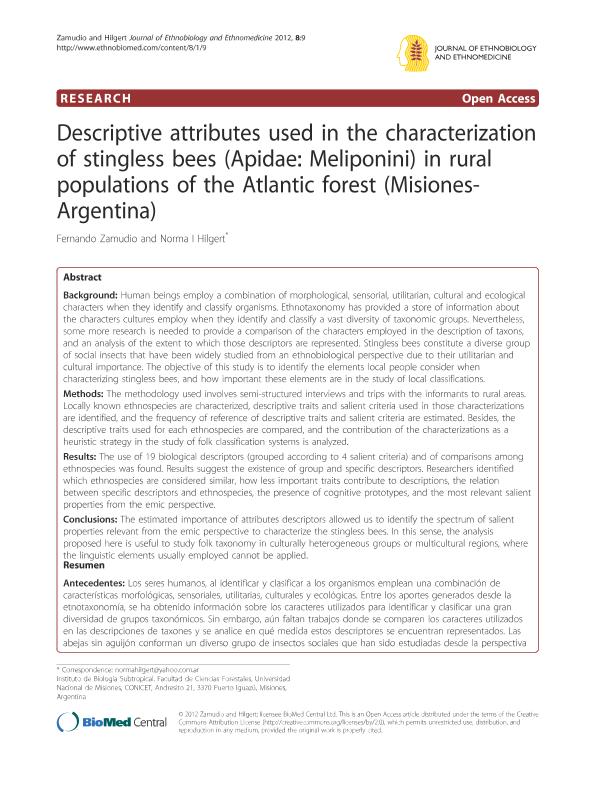Mostrar el registro sencillo del ítem
dc.contributor.author
Zamudio, Fernando

dc.contributor.author
Hilgert, Norma Ines

dc.date.available
2023-05-04T12:21:51Z
dc.date.issued
2012-02
dc.identifier.citation
Zamudio, Fernando; Hilgert, Norma Ines; Descriptive attributes used in the characterization of stingless bees (Apidae: Meliponini) in rural populations of the Atlantic forest (Misiones-Argentina); BioMed Central; Journal of Ethnobiology and Ethnomedicine; 8; 2-2012; 1-10
dc.identifier.issn
1746-4269
dc.identifier.uri
http://hdl.handle.net/11336/196236
dc.description.abstract
Background: Human beings employ a combination of morphological, sensorial, utilitarian, cultural and ecological characters when they identify and classify organisms. Ethnotaxonomy has provided a store of information about the characters cultures employ when they identify and classify a vast diversity of taxonomic groups. Nevertheless, some more research is needed to provide a comparison of the characters employed in the description of taxons, and an analysis of the extent to which those descriptors are represented. Stingless bees constitute a diverse group of social insects that have been widely studied from an ethnobiological perspective due to their utilitarian and cultural importance. The objective of this study is to identify the elements local people consider when characterizing stingless bees, and how important these elements are in the study of local classifications.Methods: The methodology used involves semi-structured interviews and trips with the informants to rural areas. Locally known ethnospecies are characterized, descriptive traits and salient criteria used in those characterizations are identified, and the frequency of reference of descriptive traits and salient criteria are estimated. Besides, the descriptive traits used for each ethnospecies are compared, and the contribution of the characterizations as a heuristic strategy in the study of folk classification systems is analyzed.Results: The use of 19 biological descriptors (grouped according to 4 salient criteria) and of comparisons among ethnospecies was found. Results suggest the existence of group and specific descriptors. Researchers identified which ethnospecies are considered similar, how less important traits contribute to descriptions, the relation between specific descriptors and ethnospecies, the presence of cognitive prototypes, and the most relevant salient properties from the emic perspective.Conclusions: The estimated importance of attributes descriptors allowed us to identify the spectrum of salient properties relevant from the emic perspective to characterize the stingless bees. In this sense, the analysis proposed here is useful to study folk taxonomy in culturally heterogeneous groups or multicultural regions, where the linguistic elements usually employed cannot be applied.
dc.description.abstract
Los seres humanos, al identificar y clasificar a los organismos emplean una combinación de características morfológicas, sensoriales, utilitarias, culturales y ecológicas. Entre los aportes generados desde la etnotaxonomía, se ha obtenido información sobre los caracteres utilizados para identificar y clasificar una gran diversidad de grupos taxonómicos. Sin embargo, aún faltan trabajos donde se comparen los caracteres utilizados en las descripciones de taxones y se analice en qué medida estos descriptores se encuentran representados. Las abejas sin aguijón conforman un diverso grupo de insectos sociales que han sido estudiadas desde la perspectiva etnobiológica, dada su importancia utilitaria y cultural. Los interrogantes que guían este trabajo son ¿Qué elementos tienen en cuenta los pobladores para caracterizar a las abejas sin aguijón? y ¿Qué importancia revisten los mismos en el estudio de las clasificaciones locales? Métodos: Se realizaron entrevistas semiestructuradas y recorridos en áreas rurales con los informantes. Se caracterizan a las etnoespecies conocidas localmente; se identifican los atributos descriptores y los criterios emergentes utilizados para dichas caracterizaciones; y se estima la frecuencia de citas de los atributos descriptores y criterios emergentes. Por otra parte, se comparan los atributos descriptores empleados para cada etnoespecie y se analiza el aporte de las caracterizaciones como estrategia heurística en el estudio de los sistemas de clasificación folclóricos. Resultados: Se halló el empleo de 19 descriptores biológicos (que fueron agrupados en 4 criterios emergentes) y de comparaciones entre etnoespecies. Los resultados sugieren la existencia de descriptores de grupo y descriptores específicos. Se identificaron cuales etnoespecies son consideradas similares, cómo contribuyen a las descripciones los atributos de menor peso, la relación entre los descriptores específicos y las etnoespecies, la presencia de prototipos cognitivos, así como las propiedades emergentes más relevantes desde la perspectiva émica. Conclusiones: La importancia estimada de los atributos descriptores nos ha permitido identificar el espectro de propiedades emergentes que son relevantes desde la perspectiva emic para caracterizar las abejas sin aguijón. En este sentido el análisis aquí propuesto es de utilidad para estudiar taxonomías folclóricas en grupos heterogéneos culturalmente o en regiones pluriculturales, donde los elementos lingüísticos usualmente empleados no son aplicables.
dc.format
application/pdf
dc.language.iso
eng
dc.publisher
BioMed Central

dc.rights
info:eu-repo/semantics/openAccess
dc.rights.uri
https://creativecommons.org/licenses/by/2.5/ar/
dc.subject
COGNITIVE PROTOTYPES
dc.subject
CRIOLLOS
dc.subject
DESCRIPTIVE TRAITS
dc.subject
EMIC
dc.subject
ETHNOZOOLOGY
dc.subject
SALIENT CRITERIA
dc.subject.classification
Conservación de la Biodiversidad

dc.subject.classification
Ciencias Biológicas

dc.subject.classification
CIENCIAS NATURALES Y EXACTAS

dc.title
Descriptive attributes used in the characterization of stingless bees (Apidae: Meliponini) in rural populations of the Atlantic forest (Misiones-Argentina)
dc.type
info:eu-repo/semantics/article
dc.type
info:ar-repo/semantics/artículo
dc.type
info:eu-repo/semantics/publishedVersion
dc.date.updated
2023-04-19T15:02:27Z
dc.journal.volume
8
dc.journal.pagination
1-10
dc.journal.pais
Reino Unido

dc.journal.ciudad
Londres
dc.description.fil
Fil: Zamudio, Fernando. Universidad Nacional de Misiones. Facultad de Ciencias Forestales. Instituto de Biología Subtropical - Sede Puerto Iguazú; Argentina. Consejo Nacional de Investigaciones Científicas y Técnicas. Centro Científico Tecnológico Conicet - Nordeste; Argentina
dc.description.fil
Fil: Hilgert, Norma Ines. Universidad Nacional de Misiones. Facultad de Ciencias Forestales. Instituto de Biología Subtropical - Sede Puerto Iguazú; Argentina. Consejo Nacional de Investigaciones Científicas y Técnicas. Centro Científico Tecnológico Conicet - Nordeste; Argentina
dc.journal.title
Journal of Ethnobiology and Ethnomedicine
dc.relation.alternativeid
info:eu-repo/semantics/altIdentifier/url/https://ethnobiomed.biomedcentral.com/articles/10.1186/1746-4269-8-9
dc.relation.alternativeid
info:eu-repo/semantics/altIdentifier/doi/http://dx.doi.org/10.1186/1746-4269-8-9
Archivos asociados
